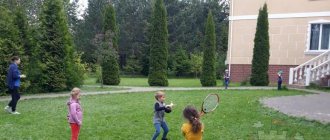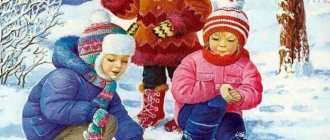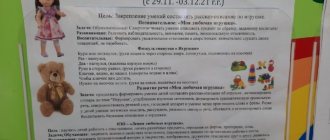Progress of observation
We get up very early. Take everyone
After all, our concern is going to work in the morning.
Why is such a profession needed? Should a driver know the rules of the road? What should a driver know to drive a car well? What kind of cars can drivers drive?
Labor activity
Raking snow in the area under trees is to cultivate a caring attitude towards nature.
Outdoor games
"Baba Yaga"
— teach to follow the rules of the game: walk, run easily and rhythmically.
“Catch-up dashes”
- learn to coordinate your actions with the actions of your comrades.
"Monkeys"
- teach how to confidently climb a rope.
Individual work
Development of movements - practice jumping on two legs, moving forward at a distance of 2-3 m.
Independent activity of children with IM
Walk 6
Truck monitoring
Purpose: to learn to distinguish a truck from a passenger car.
Progress of observation
Draw children's attention to the fact that in the fall, in the mornings, an ice crust often forms on the snow - present. This happens because the sun is shining brightly, the snow above is melting, and at night it is already frosty. The melted snow freezes, turning into an ice crust.
Labor activity
Throwing snow - teach children to use appropriate work skills.
Outdoor games
"Tram"
- strengthen children’s ability to act in accordance with the rules of the game.
"Hide and Seek"
- learning rhythmic movements, repeating the names of body parts.
"Find Your Place"
— teach children to navigate in space.
Individual work.
"Don't run into circles"
— teach children to be attentive, develop dexterity and endurance.
Games at will - teach children to find activities of interest, organize interactions with peers, select attributes for games.
Walk 10
Watching puddles.
Goal: to arouse interest in changes occurring in nature; form the concept that puddles are formed from melting snow.
Progress of observation
In the morning the puddles are covered with ice, but the ice can be broken with a shovel. During the day, when the sun begins to shine, the ice melts and puddles form again.
Labor activity
Collecting broken branches on the site - to cultivate hard work and a desire to help adults; develop teamwork skills; accustom to independently carry out assignments.
Outdoor games
"Homeless Hare"
- practice running.
"Obedient Leaves"
- teach carefully, listen to the teacher’s commands.
"Find where it's hidden"
- learn to navigate in space.
Individual work.
"We are brave and skillful"
— teach children to move along a narrow path, coordinate the movements of their arms and legs.
Independent activity of children - encourage children to act together in games, promote grouping .
Walk 11
Observation of frost and frost
Goal: to form an idea of frost as one of the states of water.
Progress of observation
The living castle growled, Two medals on the chest,
He lay down across the door. It's better not to go into the house. (Dog.)
What does a dog or cat look like? Where she lives? What does it eat? Who takes care of the dog or cat? A dog is a devoted friend of man. The dog Sharik is large, his fur coat is thick, warm, and brown. Sharik's head is large, his muzzle is elongated, and his head has hanging white ears; A beautiful tail like a ring wags its tail when it is happy. It has four paws with claws, covered with fur to prevent them from freezing in winter. A cat lives next to a person. He looks after her. The cat is big and fluffy. She has ears on her head, big eyes that glow in the dark, and a long mustache. She has four paws with soft pads. Therefore, she can walk very quietly and sneak up silently. The cat can climb fences and trees with the help of sharp claws. The cat also has a long beautiful tail. She loves Milk and eats fish and meat.
Labor activity
Collecting pebbles and leaves for crafts is to foster a desire to work together and bring joy from what you collect.
Outdoor games
"One - two"
,
“Walk silently”
- teach to walk clearly, rhythmically, with good posture and coordination of movements.
"Sly Fox"
- repeat the rules of the game; be careful.
Individual work
"Jump further"
- teach running long jump
Games at the request of children with external materials.
Walk 3
Observing trees without leaves
Goal: to consolidate the recognition of trees by appearance.
Progress of observation
Boring picture !
Endless clouds
The rain keeps pouring down
Puddles by the porch.
In rainy weather, observation from the window. Offer to listen to the rain knocking on the windows, watch how the water flows in streams, what puddles are on the paths. Note what the weather is like (rainy, cloudy, that it rains often, cold, drizzling, puddles have formed on the ground. In rainy weather, invite children to look at the ground: it has become dark, compacted, sticky, wet. Pay attention to people’s clothes (raincoats, rubber boots, holding umbrellas)
. Why do people dress like this? Rain can be warm or cold. After the rain, everything around is wet. It's raining and puddles appear. Raindrops knock on the roofs.
Labor activity
Spray indoor flowers.
Outdoor games: Walking along a ribbed path. "Fishing rod". "Fisherman".
Individual work. Didactic games. “Come up with a proposal.” “How the water makes noise.”
Independent play activity. Graphic dictation - draw how it rains from a cloud. Drawing on wet sand.
Finger gymnastics “The rain came out for a walk.”
Walk 8
Monitoring special transport - "ambulance"
Goals: expand knowledge about special transport - “ambulance”
, the role of the driver in saving lives; strengthen the ability to find the right car by description.
Progress of observation
Children take baskets and buckets. We walk through the territory, paying attention to the birch tree. Look how big the tree is. It has a thick, tall trunk. Tree trunk. It is white with black stripes. This tree is called birch. And this is a currant bush. He is short, not tall. It has many branches, but no trunk, the branches are all thin. In the summer, you and I feasted on delicious currants. Look around carefully, where else do you see birch trees? (trees? bushes)
It's a pity for the cold poor thing - He's wearing his last shirt
I gave away shreds to all the winds and breezes.
(Forest)
Labor activity
“Cleaning up the gazebo”
— teach children to carry out simple work tasks, maintain cleanliness and order in the area;
Outdoor games
"Leaf Fall"
— teach children to listen to commands, perform actions in accordance with oral instructions and demonstrations from the teacher.
"Deer and Shepherds"
— cultivate agility, endurance, develop speed skills.
"The Flock and the Shepherd"
- develop speed, agility, endurance; learn to play by the rules.
Individual work.
“Who is higher - who is further?”
— teach children to perform jumps on two legs while moving forward.
Walk 13
Ice watching
Objectives: to introduce a natural phenomenon - ice; to form an idea of the state of water in the environment.
Progress of observation
The trees stand in the frost - in bluish pillars
Either white or blue. There is smoke over the huts.
Pay attention to the frost. Frost is droplets of water vapor, only frozen, like snowflakes. Let the children carefully examine the frost on trees and bushes and touch a branch covered with frost with their palm. What happened to the branch and palm? Where did the frost go?
Labor activity
Building a snow bed encourages adults to help.
Outdoor games
"Partridges and Hunters"
- teach children to follow the rules of the game.
"Big Ball"
— teach children to follow the rules of the game, roll the ball to each other with their right and left feet.
“One, two, three - run!”
- practice the ability to act on a signal; develop running speed.
Individual work
"Naughty Balls"
- exercise children in walking and running, teach them to accompany walking with various movements, change the type of movements.
Games at the request of children with external materials
Walk 12
Excursion around the kindergarten
Purpose: to clarify the concept of “tree”, its structure; explain how to distinguish a tree from a bush.
Progress of observation
Today there is not a drop on the branches, but pieces of ice.
I walk through the mud without getting my shoes dirty.
And the former puddle of ice water
It trembles and cracks, crunches under me.
What happened to the puddle? The water turned to ice.
In cold weather, puddles become covered with a thin crust of ice. (Have the children poke a stick through the ice.)
In cold weather, puddles freeze to the bottom.
Labor activity:
Clearing the path to the feeder - improve the ability to use a shovel for snow removal
Outdoor games
"Pass quietly"
- learn to quickly change direction of movement.
"The Bees and the Bird"
— teach children to consciously follow the rules of the game.
"Migration of Birds"
- practice running in different directions.
Individual work
“Who can find the birch and spruce faster?”
— teach children to find a tree by name.
Walk 14
Watching the rain and wind
Purpose: to show that autumn rain can be different. Show the simplest connections between natural phenomena and human life. Learn to determine windy weather by external manifestations
(people dress warmly - cold wind, people dress lightly - warm wind).
Progress of observation
We are raindrops! We are tears!
They took root in the mother cloud.
Windy, windy, windy!
The whole earth has been ventilated!
Wind leaves from branches
Scattered around the world.
You can walk through puddles in rubber boots, then your feet will not get wet. A man runs through a puddle, and splashes fly in different directions. When it rains, people walk under umbrellas. A light breeze blows: caresses our cheeks. A gusty, cold wind is blowing – it’s frosty on my cheeks. Depending on the wind, people dress in
warm clothes or light clothing. Windy weather - trees sway, branches and leaves bend
in the direction of the wind. The wind is blowing, the turntables are spinning in the wind. The direction of the wind can be determined.
Labor activity
Cleaning the kindergarten area from fallen leaves.
Outdoor game: “Brave guys.” Developing jumping ability by combining strength with speed.
Individual work. Didactic games. "Day and night". “What color and size.”
Independent play activity. Games with sand and shapes.
Finger gymnastics “Little Man”
Walk 15
Cloud watching
Objectives: to introduce various natural phenomena; show the diversity of water conditions in the environment; develop a creative attitude to work.
Progress of observation
The kids really need him, he’s at the construction site and on the beach,
It’s on the paths in the yard, And it’s even melted in the glass.
(Sand)
Dry sand crumbles. If you pour water on sand, it will become wet. You can make Easter cakes and pies from wet sand. You can draw on wet sand with a stick. After playing with sand, you need to wash your hands. Why don't puddles form on sandy paths after rain? (permeable to water)
. Where and how can people use sand, given its properties? (Sand is free-flowing and allows water to pass through well, which is why it is used in road construction. Quartz sand is used in glass production). Compare the color of dry and wet sand. Wet sand can be used to sculpt and build, but dry sand crumbles. Pay attention to the soil (earth, sand, clay, digging, loosening. What is common, what is different.
Labor activity
One subgroup of children - sweeping the path on the site; the other is loosening sand in a sandbox - to cultivate diligence, the ability to work together.
Outdoor game
"Do not fall"
- strengthen the ability to pass the ball back and forth with straight arms.
"Mousetrap"
— teach children to clearly
pronounce the text .
"Throw it - catch it"
— teach children to throw and catch a ball.
Individual work
"Touch the ball"
- strengthen the ability to throw and catch the ball.
Drawing on wet sand – “Wildflowers”
- strengthen children’s ability to convey the position of objects in space on damp sand.
Walk 2
Pet monitoring
Objectives: to form an idea of the appearance of the animal; cultivate the need to take care of a pet.



